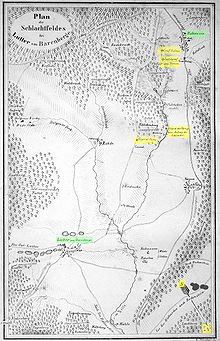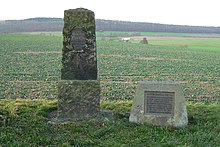Battle of Lutter
| date | August 17th Jul. / August 27, 1626 greg. |
|---|---|
| place | Lutter am Barenberge |
| output | Catholic League defeats the Danes |
| Parties to the conflict | |
|---|---|
|
Imperial (Catholic) Army |
Danish (Protestant) army |
| Commander | |
| Troop strength | |
| 15,000 infantry, 5,000 riders, 18 guns |
16,000 infantry 6,500 horsemen 22 guns |
| losses | |
|
200–4,000 dead |
4,000 dead |
In the battle of Lutter am Barenberge , about 10 kilometers southwest of today's Salzgitter , defeated on August 17th July. / August 27, 1626 greg. the troops of the emperor and the Catholic League under Johann t'Serclaes von Tilly the army of the Lower Saxony district and Denmark under King Christian IV. As a result, there was a separate peace in Lübeck in 1629 , which ended the Danish-Lower Saxon partial conflict of the Thirty Years' War .
With around 40,000 fighters and 4,000 to 8,000 dead, the battle of Lutter, alongside that of Sievershausen in 1553, was one of the bloodiest armed conflicts in what is now Lower Saxony .
prehistory
The Lower Saxony Imperial Circle had elected King Christian IV, who as Duke of Holstein was German imperial prince, to be field bishop. He was supposed to protect the area against the Catholic League and support the Protestant cause . In the war year 1626 he planned a campaign in consultation with his ally Count Mansfeld , which was to be directed first against Thuringia and then against southern Germany . His war aims were the liberation of today's Lower Saxony from enemy troops, the separation of the imperial armies of the generals Tilly and Wallenstein as well as the cleansing and occupation of Hesse. In the summer of 1626 the king and his army were at Wolfenbüttel . In order to drive out the imperial general Tilly, Christian IV moved south and met the imperial army on August 16 near Northeim .
Tilly recognized the overwhelming power of the Protestant side and withdrew to Nörten-Hardenberg to await reinforcement from General Albrecht von Wallenstein . It was approaching from the Blankenburg area . Christian IV initially wanted to destroy Wallenstein's army, but this failed because he misjudged the approach. The Danish king wanted to avoid the battle by retreating to the fortified city of Wolfenbüttel. During the withdrawal movement, Christian's army was violently attacked. On August 25, 1626 there was a battle between Tilly's vanguard and Christian's rear guard at the Stauffenburg . The Danes lost 600 men and two guns. Finally, the persecuted Danes had to face an open field battle in the open area near Lutter am Barenberge.
Course of the battle

The battle took place on August 27, 1626 in the plain of the Lutter basin , a flat area southwest of Lutter am Barenberge. In older traditions the date of August 17th is mentioned, which is due to the old Julian calendar . The fight began at 10 a.m. with an attack by three heavy cavalry regiments of the Imperial Army under Colonel Nikolaus Dufour. At 11 o'clock the imperial battery opened fire and another cavalry regiment attacked the Danish battery. The infantry followed the attack. The Danish battery and the Danish cavalry under the command of the advance guard of General Hans Philipp Fuchs von Bimbach and Oberisten Markwart von Pentz repulsed the attack.
The Danes then launched their counterattack against the imperial battery , which was a resounding success. Tilly personally stopped his fleeing mercenaries and led them back after the gathering. He recognized the danger of a breakthrough and built up reserves early on. When the imperial cavalry intervened and the Danish generals Count Solms and Prince Philip of Hesse-Kassel fell in the cavalry battle , the Danes fled. The Danes thus suffered a defeat on their right wing in the first phase of the battle.
The 2nd phase took place on the left wing of the Danes. Here the Danish commander-in-chief, King Christian IV, withdrew troops, as he had received news that Wallenstein's troops were approaching behind . At that moment, two imperial regiments attacked, which initiated the third phase of the battle. The stricken Danes could not withstand the attack and the army dissolved in a panic. Some of the infantry fled to Lutter Castle in nearby Lutter am Barenberge and prepared themselves for defense. The imperial closed the place and shelled it. The 2,000 Danes who were trapped surrendered and were taken prisoner. After winning the battle, Tilly's mercenaries, mainly Croatian horsemen , hunted down wounded and fled Danes. The persecution lasted into the night, in which, according to Tilly's orders, people were killed without mercy. The cable of the Danes were persecuted and plundered. Twenty cannons were captured on the battlefield.
In the last phase of the battle, the Danish king had gathered 300 noble horsemen around him. With a bunch of cavalry of about 50 men he managed to escape. He returned to his court in Stade , where he arrived about a month later.
losses
According to contemporary accounts, the Danes suffered around 4,000 deaths, mainly infantrymen, and 2,500 of them were taken prisoner. The data on the losses on the imperial side differ widely and differ between 200 and 4,000 dead. The following fell to Danish colonels :
- Hans Philipp Fuchs from Bimbach
- Prince Philipp of Hessen-Kassel , son of Landgrave Moritz von Hessen-Kassel
- Count Hermann Adolph von Solms-Hohensolms
- Wolf Heinrich von Wersebe
- Markwart von Pentz died a few months after the battle of the injuries
Result of the battle
The Battle of Lutter was Tilly's 18th victory, which, according to a letter to Emperor Ferdinand II, he considered more important than the Battle of White Mountain near Prague . Tilly received letters of thanks and praise for the victory, including a letter from Pope Urban :
“Hail and apostolic blessings to you. Whoever knows how to wage war skillfully in this way will achieve such victories as you usually achieve over the infidelity of the heretics . On then, dear son, to exterminate the heretics ... "
After the battle of Lutter, all of the north German princes gave up their support for Christian IV except for the dukes of Mecklenburg . The battle initiated the gradual end of the Danish-Lower Saxon War early on . This partial war of the Thirty Years' War ended in 1629 with the Peace of Lübeck .
The battlefield today
On the former site of the battle, southwest of Lutter, there are two memorial stones at a parking lot on the B 248 . They remember Colonel Hans Philipp Fuchs von Bimbach , who was in command on the Danish side , a Frankish imperial knight who was shot from a horse in the area there. According to his wishes, he was buried near the battlefield. His descendants had his grave tended until the end of the 18th century. When the highway B 248 was built in the 19th century, his grave was opened and a sword was found next to his skeleton.
According to legend, so much blood flowed during the battle that the soil in the Lutter basin turned into a red blood field . In fact, the reddish color of the soil is due to the iron content in the red sandstone , which was blown here on the northern edge of the Harz as loess around 50,000 years ago.
Search for clues
In 2011 a project was launched to prospect the battlefield with metal detectors . The Braunschweig regional team of the Lower Saxony State Office for Monument Preservation and members of the Ostfalensucher interest group were involved as a group of archaeologically interested probe goers. The group had already carried out surveys on similar battlefields, such as the Kalkriese discovery region , the battle of Wittstock and the Harzhorn . An area of 8 km² was examined in the Lutter basin. In addition to finds from the Neolithic , the Iron Age , the Migration Period and the Middle Ages, as well as a hoard find with three silver coins from the late 16th to early 17th centuries and clothing and equipment, a veil of musket balls was visible in the ground . The work was temporarily completed in 2017. In the evaluation, a distinction was made between shot (deformed) and not shot lead balls. It resulted in a high concentration of fired bullets on the Pöbbeckenberg and a smaller one in the northwest of Nauen, which indicates the focus of the battle. Bullets that had not been fired could be found heaped east of the B 248 towards Lutter.
literature
- G. Lichtenstein: The battle at Lutter am Barenberge. A contribution to patriotic history (= Denmark's participation in the Thirty Years War up to the Peace of Lübeck). Braunschweig: Oehme & Müller 1850 [ digitized version ]
- Paul Douglas Lockhart: Denmark in the Thirty Years' War 1618-1648. King Christian IV and the Decline of the Oldenburg State. London 1996
- Julius Otto Opel : The Lower Saxon-Danish War. Halle / Magdeburg 1872–94
- Klauspeter Reumann: Church regiment and great power politics. The intervention of Christian IV as Duke of Holstein and King of Denmark in the Thirty Years War. In: Bernd Hey (ed.): The Peace of Westphalia 1648 and German Protestantism. Bielefeld 1998, pp. 41-63
- Ole Stender-Petersen: Harzskytterne. Et Glemt Chapter I Christian 4.s Nedersachsiske Krig [Die Harz-Guerilla. A forgotten chapter in Christian IV's War in Lower Saxony]. In: Historie 13/3 (1980), pp. 49-70
- Hermann Voges : The battle of Lutter am Barenberge on August 27, 1626. Leipzig 1922
- Kim A. Wagner: The Battle of Lutter am Bahrenberg. In: Military and Naval History Journal. 10 (1999), pp. 15-35
- Ernst Andreas Friedrich : The blood field in the Lutter basin, pp. 196-196, in: If stones could talk , Volume I, Landbuch-Verlag, Hanover 1989, ISBN 3-7842-03973 .
- Tore Rodehorst: The Battle of Lutter am Barenberge in the Thirty Years War. A battlefield with open questions. in: Archeology in Lower Saxony , Vol. 17. Oldenburg 2014, pp. 110–113
- Arne Homann: Archaeological investigations on the battlefield near Lutter am Barenberge from August 27, 1626 in: Nachrichten aus Niedersachsens Urgeschichte , Vol. 87, Stuttgart, 2018, pp. 205–212. ( Online , pdf)
Footnotes
- ^ Bernd Warlich: The Thirty Years' War in personal testimonies, chronicles and reports ( Memento from September 7, 2014 in the Internet Archive ).
- ↑ No evidence of the original text
- ↑ Arne Homann: Archaeological investigations on the battlefield near Lutter am Barenberge from August 27, 1626. In: Nachrichten aus Niedersachsens Urgeschichte 87 (2018), pp. 205–212.
Web links
- Reproduction of an engraving of the Battle of Lutter
- G. Lichtenstein: The battle at Lutter am Barenberge. Braunschweig, 1850
Coordinates: 51 ° 58 ′ 1 ″ N , 10 ° 14 ′ 19 ″ E




